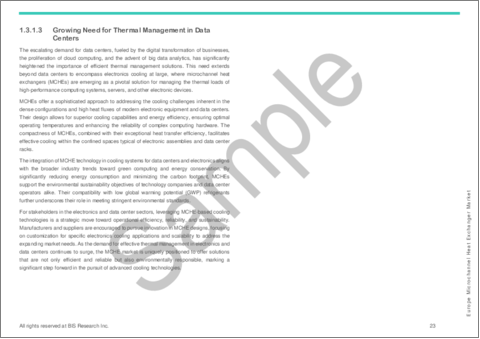|
|
市場調査レポート
商品コード
1622830
欧州のマイクロチャネル熱交換器市場:用途別、製品別、国別 - 分析と予測(2024年~2033年)Europe Microchannel Heat Exchanger Market: Focus on Application, Product, and Country - Analysis and Forecast, 2024-2033 |
||||||
カスタマイズ可能
|
|||||||
| 欧州のマイクロチャネル熱交換器市場:用途別、製品別、国別 - 分析と予測(2024年~2033年) |
|
出版日: 2024年12月27日
発行: BIS Research
ページ情報: 英文 68 Pages
納期: 1~5営業日
|
全表示
- 概要
- 図表
- 目次
欧州のマイクロチャネル熱交換器の市場規模は、2024年の42億6,300万米ドルから2033年には91億2,570万米ドルに達し、予測期間の2024年~2033年のCAGRは8.82%になると予測されています。
欧州のマイクロチャネル熱交換器市場は、再生可能エネルギー、自動車、HVACなどの産業でエネルギー使用量の少ない熱管理システムのニーズが高まっていることから急成長しています。同地域では高度な熱管理が優先され、電気自動車への切り替えが進んでいるため、小型で高効率なマイクロチャネル熱交換器は特に重宝されています。
循環型経済と材料回収は、普及しつつある持続可能な慣行の2つの例であり、環境意識も採用を加速させています。産業界が地域レベルで二酸化炭素排出量の削減に重点を置く中、環境にやさしくエネルギー効率の高いソリューションの重要性はますます高まっています。マイクロチャネル熱交換器の設計と運転における技術的進歩も、研究開発への大規模投資によって推進されています。
| 主要市場統計 | |
|---|---|
| 予測期間 | 2024年~2033年 |
| 2024年の評価 | 42億6,300万米ドル |
| 2033年の予測 | 91億2,570万米ドル |
| CAGR | 8.82% |
さらに、欧州の各産業において、安定した市場成長と変化する需要に対応する能力を保証するためには、サプライチェーンの強靭性を強化することが依然として最優先課題となっています。
欧州のマイクロチャネル熱交換器(MCHE)市場は、再生可能エネルギー、自動車、暖房・換気・空調(HVAC)など、さまざまな産業でエネルギー効率の高い熱管理ソリューションに注目が集まっているため、急速に拡大しています。MCHEは高効率、軽量設計、コンパクトサイズであるため、性能とスペースが重要な要素となるアプリケーションで高く評価されています。
欧州が再生可能エネルギー源や電気自動車(EV)への切り替えを加速するにつれ、MCHEなどの高度な熱管理ソリューションの必要性が高まっています。この地域の厳しい環境規制と二酸化炭素削減目標は、エネルギー効率を向上させる能力と完全に一致しています。さらに、この地域が環境への影響を軽減することに専心していることは、材料回収や循環経済のような持続可能な製造慣行の採用によって実証されています。
欧州の研究開発イニシアティブは、性能の向上と材料の最適化に重点を置いたMCHE設計の革新を促しています。市場の成長軌道は、安定した供給力と品質を保証するサプライチェーンの回復力への投資によってさらに強化されています。
当レポートでは、欧州のマイクロチャネル熱交換器市場について調査し、市場の概要とともに、用途別、製品別、国別の動向、および市場に参入する企業のプロファイルなどを提供しています。
目次
エグゼクティブサマリー
第1章 市場
- 動向:現在および将来の影響評価
- サプライチェーンの概要
- 研究開発レビュー
- 規制状況
- ステークホルダー分析
- 主要な世界的出来事の影響分析-COVID-19、ロシア/ウクライナ、中東危機
- 主な開発と進行中のプロジェクト
- 市場力学:概要
第2章 地域
- 地域別概要
- 促進要因と抑制要因
- 欧州
第3章 市場-競合ベンチマーキングと企業プロファイル
- 今後の見通し
- 地理的評価
- MAHLE GmbH
- Climetal S.L.
- Kaltra GmbH
- Norsk Hydro ASA
第4章 調査手法
List of Figures
- Figure 1: Microchannel Heat Exchanger Market (by Region), $Million, 2023, 2027, and 2033
- Figure 2: Europe Microchannel Heat Exchanger Market (by End-Use Industry), $Million, 2023, 2027, and 2033
- Figure 3: Europe Microchannel Heat Exchanger Market (by Material Type), $Million, 2023, 2027, and 2033
- Figure 4: Europe Microchannel Heat Exchanger Market (by Fluid Mechanism), $Million, 2023, 2027, and 2033
- Figure 5: Microchannel Heat Exchanger Market, Recent Developments
- Figure 6: Supply Chain and Risks within the Supply Chain
- Figure 7: Microchannel Heat Exchanger Market (by Capacity (kW)), Global Pricing Snapshot, $U.S./Unit, 2023-2033
- Figure 8: Patent Analysis (by Country), January 2020 and December 2023
- Figure 9: Patent Analysis (by Company), January 2020 and December 2023
- Figure 10: Germany Microchannel Heat Exchanger Market, $Million, 2023-2033
- Figure 11: France Microchannel Heat Exchanger Market, $Million, 2023-2033
- Figure 12: Italy Microchannel Heat Exchanger Market, $Million, 2023-2033
- Figure 13: Spain Microchannel Heat Exchanger Market, $Million, 2023-2033
- Figure 14: U.K. Microchannel Heat Exchanger Market, $Million, 2023-2033
- Figure 15: Rest-of-Europe Microchannel Heat Exchanger Market, $Million, 2023-2033
- Figure 16: Strategic Initiatives, 2021-2023
- Figure 17: Share of Strategic Initiatives, 2021-2023
- Figure 18: Data Triangulation
- Figure 19: Top-Down and Bottom-Up Approach
- Figure 20: Assumptions and Limitations
List of Tables
- Table 1: Market Snapshot
- Table 2: Microchannel Heat Exchanger Market, Opportunities across Regions
- Table 2: Impact Analysis of Market Navigating Factors, 2024-2033
- Table 1: Microchannel Heat Exchanger Market (by Region), $Million, 2023-2033
- Table 2: Europe Microchannel Heat Exchanger Market (by End-Use Industry), $Million, 2023-2033
- Table 3: Europe Microchannel Heat Exchanger Market (by Material Type), $Million, 2023-2033
- Table 4: Europe Microchannel Heat Exchanger Market (by Fluid Mechanism), $Million, 2023-2033
- Table 5: Germany Microchannel Heat Exchanger Market (by End-Use Industry), $Million, 2023-2033
- Table 6: Germany Microchannel Heat Exchanger Market (by Material Type), $Million, 2023-2033
- Table 7: Germany Microchannel Heat Exchanger Market (by Fluid Mechanism), $Million, 2023-2033
- Table 8: France Microchannel Heat Exchanger Market (by End-Use Industry), $Million, 2023-2033
- Table 9: France Microchannel Heat Exchanger Market (by Material Type), $Million, 2023-2033
- Table 10: France Microchannel Heat Exchanger Market (by Fluid Mechanism), $Million, 2023-2033
- Table 11: Italy Microchannel Heat Exchanger Market (by End-Use Industry), $Million, 2023-2033
- Table 12: Italy Microchannel Heat Exchanger Market (by Material Type), $Million, 2023-2033
- Table 13: Italy Microchannel Heat Exchanger Market (by Fluid Mechanism), $Million, 2023-2033
- Table 14: Spain Microchannel Heat Exchanger Market (by End-Use Industry), $Million, 2023-2033
- Table 15: Spain Microchannel Heat Exchanger Market (by Material Type), $Million, 2023-2033
- Table 16: Spain Microchannel Heat Exchanger Market (by Fluid Mechanism), $Million, 2023-2033
- Table 17: U.K. Microchannel Heat Exchanger Market (by End-Use Industry), $Million, 2023-2033
- Table 18: U.K. Microchannel Heat Exchanger Market (by Material Type), $Million, 2023-2033
- Table 19: U.K. Microchannel Heat Exchanger Market (by Fluid Mechanism), $Million, 2023-2033
- Table 20: Rest-of-Europe Microchannel Heat Exchanger Market (by End-Use Industry), $Million, 2023-2033
- Table 21: Rest-of-Europe Microchannel Heat Exchanger Market (by Material Type), $Million, 2023-2033
- Table 22: Rest-of-Europe Microchannel Heat Exchanger Market (by Fluid Mechanism), $Million, 2023-2033
- Table 23: Market Share
Introduction to Europe Microchannel Heat Exchanger Market
The Europe microchannel heat exchanger market is projected to reach $9,125.7 million by 2033 from $4,263.0 million in 2024, growing at a CAGR of 8.82% during the forecast period 2024-2033. The market for microchannel heat exchangers in Europe is growing quickly due to the rising need for thermal management systems that use less energy in industries like renewable energy, automotive, and HVAC. As the area prioritizes advanced thermal management and makes the switch to electric vehicles, microchannel heat exchangers are especially valuable due to their small size and high efficiency.
The circular economy and material recovery are two examples of sustainable practices that are becoming more popular, and environmental awareness also speeds up adoption. Environmentally friendly and energy-efficient solutions are becoming more and more important as industries place a greater emphasis on lowering carbon emissions on a regional level. Technical advancements in the design and operation of microchannel heat exchangers are also being driven by large investments in research and development.
| KEY MARKET STATISTICS | |
|---|---|
| Forecast Period | 2024 - 2033 |
| 2024 Evaluation | $4,263.0 Million |
| 2033 Forecast | $9,125.7 Million |
| CAGR | 8.82% |
Furthermore, strengthening supply chain resilience is still a top priority in order to guarantee consistent market growth and the capacity to meet evolving demands across industries in Europe.
Market Introduction
The market for microchannel heat exchangers (MCHEs) in Europe is expanding rapidly due to the region's focus on energy-efficient thermal management solutions in a variety of industries, including renewable energy, automotive, and heating, ventilation, and air conditioning (HVAC). Because of their high efficiency, lightweight design, and compact size, MCHEs are highly valued in applications where performance and space are crucial factors.
The need for sophisticated thermal management solutions, such as MCHEs, has increased as Europe speeds up its switch to renewable energy sources and electric vehicles (EVs). The region's strict environmental regulations and carbon reduction objectives are perfectly aligned with their capacity to improve energy efficiency. Additionally, the region's dedication to lessening its environmental impact is demonstrated by the adoption of sustainable manufacturing practices like material recovery and the circular economy.
European research and development initiatives are encouraging innovation in MCHE design with an emphasis on improved performance and material optimization. The market's growth trajectory is being further reinforced by investments in supply chain resilience, which guarantee consistent availability and quality.
The European MCHE market is expected to grow steadily due to its increasing use in both established and new applications. It is essential to achieving the region's objectives for sustainability, energy efficiency, and technological leadership in thermal management solutions.
Market Segmentation
Segmentation 1: by End-Use Industry
- Automotive
- HVAC
- Commercial Refrigeration
- Others
Segmentation 2: by Material Type
- Metal
- Ceramic
Segmentation 3: by Fluid Mechanism
- Single Coil
- Dual Coil
- Multi Coil
Segmentation 4: by Country
- Germany
- France
- Italy
- Spain
- U.K.
- Rest-of-Europe
How can this report add value to an organization?
Product/Innovation Strategy: This report provides a comprehensive product/innovation strategy for the Europe microchannel heat exchanger market, identifying opportunities for market entry, technology adoption, and sustainable growth. It offers actionable insights, helping organizations leverage microchannel heat exchangers to meet environmental standards, gain a competitive edge, and capitalize on the increasing demand for eco-friendly solutions in various industries.
Growth/Marketing Strategy: This report offers a comprehensive growth and marketing strategy designed specifically for the microchannel heat exchanger market. It presents a targeted approach to identifying specialized market segments, establishing a competitive advantage, and implementing creative marketing initiatives aimed at optimizing market share and financial performance. By harnessing these strategic recommendations, organizations can elevate their market presence, seize emerging prospects, and efficiently propel revenue expansion.
Competitive Strategy: This report crafts a strong competitive strategy tailored to the Europe microchannel heat exchanger market. It evaluates market rivals, suggests methods to stand out, and offers guidance for maintaining a competitive edge. By adhering to these strategic directives, companies can position themselves effectively in the face of market competition, ensuring sustained prosperity and profitability.
Table of Contents
Executive Summary
Scope and Definition
1 Markets
- 1.1 Trends: Current and Future Impact Assessment
- 1.1.1 Trends: Current and Future Impact Assessment
- 1.1.1.1 Rise in Demand for Microchannel Heat Exchangers (MCHEs) in the Manufacturing Industry
- 1.1.1.2 Rapid Growth of the Construction Industry Worldwide
- 1.1.1 Trends: Current and Future Impact Assessment
- 1.2 Supply Chain Overview
- 1.2.1 Value Chain Analysis
- 1.2.2 Market Map
- 1.2.2.1 Microchannel Heat Exchanger Market - by End-Use Industry
- 1.2.2.1.1 Automotive
- 1.2.2.1.2 Heating, Ventilation, and Air Conditioning (HVAC)
- 1.2.2.1.3 Commercial Refrigeration
- 1.2.2.1.4 Others
- 1.2.2.1 Microchannel Heat Exchanger Market - by End-Use Industry
- 1.2.3 Pricing Forecast
- 1.3 Research and Development Review
- 1.3.1 Patent Filing Trend (by Country and Company)
- 1.4 Regulatory Landscape
- 1.5 Stakeholder Analysis
- 1.5.1 Use Case
- 1.5.2 End User and Buying Criteria
- 1.6 Impact Analysis for Key Global Events-COVID-19, Russia/Ukraine, or Middle East Crisis
- 1.7 Major Developments and Ongoing Projects
- 1.8 Market Dynamics: Overview
- 1.8.1 Market Drivers
- 1.8.1.1 Stringent Environmental Standards and Energy Efficiency Regulations
- 1.8.1.2 High Demand from Heating, Ventilation, Air Conditioning, and Refrigeration (HVAC&R) Industry
- 1.8.1.3 Growing Need for Thermal Management in Data Centers
- 1.8.2 Market Restraints
- 1.8.2.1 High Costs of Production and Manufacturing Complexities
- 1.8.2.2 Concerns Regarding Reliability and Durability of Microchannel Heat Exchangers
- 1.8.3 Market Opportunities
- 1.8.3.1 Expanding Incorporation of Microchannel Heat Exchangers in Renewable Energy
- 1.8.3.2 Increasing Usage in the Automotive Industry
- 1.8.1 Market Drivers
2 Regions
- 2.1 Regional Summary
- 2.2 Drivers and Restraints
- 2.3 Europe
- 2.3.1 Regional Overview
- 2.3.2 Driving Factors for Market Growth
- 2.3.3 Factors Challenging the Market
- 2.3.3.1 Application
- 2.3.3.2 Product
- 2.3.4 Germany
- 2.3.4.1 Application
- 2.3.4.2 Product
- 2.3.5 France
- 2.3.5.1 Application
- 2.3.5.2 Product
- 2.3.6 Italy
- 2.3.6.1 Application
- 2.3.6.2 Product
- 2.3.7 Spain
- 2.3.7.1 Application
- 2.3.7.2 Product
- 2.3.8 U.K.
- 2.3.8.1 Application
- 2.3.8.2 Product
- 2.3.9 Rest-of-Europe
- 2.3.9.1 Application
- 2.3.9.2 Product
3 Markets - Competitive Benchmarking & Company Profiles
- 3.1 Next Frontiers
- 3.2 Geographic Assessment
- 3.2.1 MAHLE GmbH
- 3.2.1.1 Overview
- 3.2.1.2 Top Products/Product Portfolio
- 3.2.1.3 Top Competitors
- 3.2.1.4 Target Customers
- 3.2.1.5 Key Personnel
- 3.2.1.6 Analyst View
- 3.2.1.7 Market Share, 2022
- 3.2.2 Climetal S.L.
- 3.2.2.1 Overview
- 3.2.2.2 Top Products/Product Portfolio
- 3.2.2.3 Top Competitors
- 3.2.2.4 Target Customers
- 3.2.2.5 Key Personnel
- 3.2.2.6 Analyst View
- 3.2.2.7 Market Share, 2022
- 3.2.3 Kaltra GmbH
- 3.2.3.1 Overview
- 3.2.3.2 Top Products/Product Portfolio
- 3.2.3.3 Top Competitors
- 3.2.3.4 Target Customers
- 3.2.3.5 Key Personnel
- 3.2.3.6 Analyst View
- 3.2.4 Norsk Hydro ASA
- 3.2.4.1 Overview
- 3.2.4.2 Top Products/Product Portfolio
- 3.2.4.3 Top Competitors
- 3.2.4.4 Target Customers
- 3.2.4.5 Key Personnel
- 3.2.4.6 Analyst View
- 3.2.4.7 Market Share, 2022
- 3.2.1 MAHLE GmbH
4 Research Methodology
- 4.1 Data Sources
- 4.1.1 Primary Data Sources
- 4.1.2 Secondary Data Sources
- 4.1.3 Data Triangulation
- 4.2 Market Estimation and Forecast






